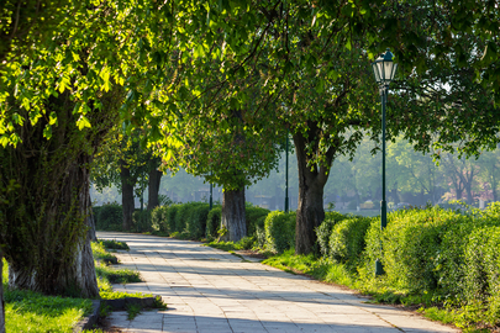Expanding an urban forest can be a challenging task with many steps, from community outreach to implementation to maintenance. But none of those steps could happen without funds—and finding channels to gather funds is another undertaking in and of itself.
In 2021, President Biden signed the Infrastructure Investment and Jobs Act (IIJA) into law. The IIJA will invest $1.2 billion in the U.S.’s core infrastructure priorities, including roads and bridges, rail, transit, airports, the electric grid, water systems, and broadband. The funds will also be invested in environmental causes, such as tackling climate change and advancing environmental justice.
Within the IIJA, the Healthy Streets Program uses grant funds to encourage urban forestry projects aimed at tackling climate change and environmental justice through roadways built using green infrastructure elements. The Healthy Streets Program is based on a set of indicators that are meant to improve social, economic, and environmental sustainability through improving existing roadways in underdeveloped communities.
How Urban Forestry Plays A Role
The Healthy Streets Program mentions tree planting and green infrastructure installation as part of its mission to mitigate urban heat islands, improve air quality, reduce stormwater runoff and flood risks from impervious surfaces, and reduce heat impacts from infrastructure and road users.
The Healthy Streets Program funding can be used to:
- Conduct an assessment of urban heat islands to identify areas with extreme heat or an elevated area of air pollution.
- Conduct a comprehensive tree canopy assessment to gauge tree location, species, condition, and health as well as identify locations where trees need to be replaced, added, and planted to mitigate flooding in flood-prone areas.
- Conduct an equity assessment by mapping tree canopy gaps, flood-prone locations, and urban heat island spots compared to pedestrian walkways, public transportation stops, and underdeveloped communities.
- Plan activities and develop an investment plan based on the assessments.
- Purchase and install cool pavements.
- Purchase and install porous pavements in pedestrian-only areas and areas of low-volume, low-speed traffic.
- Purchase and plant trees, including site preparation, ongoing maintenance and monitoring, and repairing storm-damaged trees. Tree plantings should prioritize native species in areas with low tree cover or higher summer temperatures.
The program is newly authorized, but not yet appropriated. When the funding becomes available, there will be an 80% federal share of the cost for projects in urbanized areas, and awardees can receive a maximum of $15 million per project from the program.
Taking On the Task
With the introduction of the Healthy Streets Program, municipalities can do the double duty of creating safer roadways for the members of their communities who need it most while expanding their urban forest in low-canopy areas. Grant applications are being accepted now–don’t wait to get your project funded by this new program!
Davey Resource Group, Inc.’s (DRG’s) grant writing experts can help you with the application process from start to finish to ensure you get the most funding possible.




